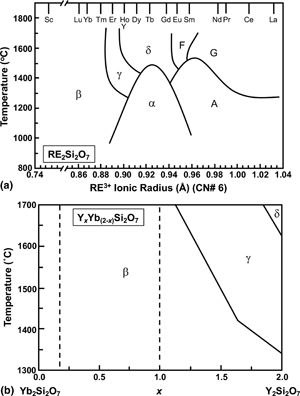Crossref Citations
This article has been cited by the following publications. This list is generated based on data provided by
Crossref.
Turcer, Laura R.
Sengupta, Arundhati
and
Padture, Nitin P.
2021.
Low thermal conductivity in high-entropy rare-earth pyrosilicate solid-solutions for thermal environmental barrier coatings.
Scripta Materialia,
Vol. 191,
Issue. ,
p.
40.
Cao, Gui
Wang, Yu-Hao
Ding, Zhao-Ying
Liu, Zhan-Guo
Ouyang, Jia-Hu
Wang, Ya-Ming
and
Wang, Yu-Jin
2021.
CMAS hot corrosion behavior of rare-earth silicates for environmental barrier coatings applications: a comprehensive review.
Heat Treatment and Surface Engineering,
Vol. 3,
Issue. 1,
p.
9.
Dong, Lin
Liu, Mei-Jun
Zhang, Xiaofeng
and
Zhou, Kesong
2021.
Low temperature in-situ formation of oxygen barriers by heat treatment of aluminum infiltrated environmental barrier coatings.
Ceramics International,
Vol. 47,
Issue. 24,
p.
34463.
Nieto, Andy
Samayoa, Erick
Ansell, Troy
and
Luo, Jian
2021.
Unusual temperature-dependent reactivity of ultra-high temperature ceramic (UHTC) borides with calcia-magnesia-alumina-silicate (CMAS).
Materialia,
Vol. 20,
Issue. ,
p.
101265.
Dong, Lin
Liu, Mei-Jun
Zhang, Xiao-Feng
Zhuo, Xue-Shi
Fan, Jia-Feng
Yang, Guan-Jun
and
Zhou, Ke-Song
2022.
Pressure infiltration of molten aluminum for densification of environmental barrier coatings.
Journal of Advanced Ceramics,
Vol. 11,
Issue. 1,
p.
145.
Sun, Luchao
Ren, Xiaomin
Luo, Yixiu
Lv, Xirui
Wang, Jiemin
Oh, Yoonsuk
and
Wang, Jingyang
2022.
Exploration of the mechanism of enhanced CMAS corrosion resistance at 1500 °C for multicomponent (Er0.25Tm0.25Yb0.25Lu0.25)2Si2O7 disilicate.
Corrosion Science,
Vol. 203,
Issue. ,
p.
110343.
Zhang, Qi
Zhang, Xueqin
Ma, Zhuang
Liu, Ling
Liu, Yanbo
and
Zheng, Wei
2022.
Water vapor and CMAS corrosion tests of Y2SiO5/Si thermal and environmental barrier coating.
Heliyon,
Vol. 8,
Issue. 9,
p.
e10262.
Du, Jinping
Liu, Rongjun
Wan, Fan
Li, Duan
Li, Junsheng
and
Wang, Yanfei
2022.
Failure mechanism of ytterbium silicate/silicon bi-layer environmental barrier coatings on SiCf/SiC composites upon long-time water vapor and oxygen corrosion test.
Surface and Coatings Technology,
Vol. 447,
Issue. ,
p.
128871.
Ridley, Mackenzie J.
Tomko, Kathleen Q.
Tomko, John A.
Hoglund, Eric R.
Howe, James M.
Hopkins, Patrick E.
and
Opila, Elizabeth J.
2022.
Tailoring thermal and chemical properties of a multi-component environmental barrier coating candidate (Sc0.2Nd0.2Er0.2Yb0.2Lu0.2)2Si2O7.
Materialia,
Vol. 26,
Issue. ,
p.
101557.
Sternlicht, Hadas
McComb, David W.
and
Padture, Nitin P.
2022.
Interaction of ytterbium pyrosilicate environmental-barrier-coating ceramics with molten calcia-magnesia-aluminosilicate glass: Part I, Microstructures.
Acta Materialia,
Vol. 241,
Issue. ,
p.
118360.
Zhang, Zhenya
Park, Youngjin
Xue, Zhaolu
Zhang, Shihong
Byon, Eungsun
and
Koo, Bon‐Heun
2022.
Research status of bond coats in environmental barrier coatings.
International Journal of Applied Ceramic Technology,
Vol. 19,
Issue. 4,
p.
1841.
Guo, Xiaotong
Zhang, Yulei
Li, Tao
Zhang, Pengfei
Shuai, Kang
Li, Jie
and
Shi, Xiaohong
2022.
High-entropy rare-earth disilicate (Lu0.2Yb0.2Er0.2Tm0.2Sc0.2)2Si2O7: A potential environmental barrier coating material.
Journal of the European Ceramic Society,
Vol. 42,
Issue. 8,
p.
3570.
Cao, Gui
Wang, Shu-Qi
Wang, Yu-Hao
Ding, Zhao-Ying
Liu, Zhan-Guo
Ouyang, Jia-Hu
Wang, Ya-Ming
and
Wang, Yu-Jin
2023.
Growth kinetics of apatite layer evolved from calcia-magnesia-aluminosilicate (CMAS) hot corrosion reaction of (Y1-Yb )2SiO5 ceramics at elevated temperatures of 1673 K and 1773 K.
Journal of the European Ceramic Society,
Vol. 43,
Issue. 2,
p.
600.
Guo, Lei
Feng, Jiayi
Liu, Mingguang
Sun, Jingyong
Yang, Shuo
Jin, Lei
and
Ye, Fuxing
2023.
Yb doping effects on CMAS corrosion resistance of Yb-doped GdPO4 by first-principles calculation and experimental investigation.
Corrosion Science,
Vol. 218,
Issue. ,
p.
111175.
Xiao, Shikang
Li, Jianzhang
Huang, Panxin
Zhang, Antong
Tian, Yuhang
Zhang, Xu
Zhang, Jingde
Ryu, Jungho
and
Han, Guifang
2023.
Evaluation of environmental barrier coatings: A review.
International Journal of Applied Ceramic Technology,
Vol. 20,
Issue. 4,
p.
2055.
Zhang, Zhenya
Park, Youngjin
Kim, Do Hyun
Xue, Zhaolu
Ji, Xiaojuan
Park, Hunkwan
Zhang, Shihong
Byon, Eungsun
and
Koo, Bon Heun
2023.
High-temperature oxidation performance of novel environmental barrier coating 50HfO2-50SiO2/YxYb(2−x)Si2O7 at 1475 °C.
Journal of the European Ceramic Society,
Vol. 43,
Issue. 3,
p.
1127.
Guo, Lei
Wang, Yuanpeng
Liu, Mingguang
Gao, Yuan
and
Ye, Fuxing
2023.
CeO2 Protective Material against CMAS Attack for Thermal–Environmental Barrier Coating Applications.
Coatings,
Vol. 13,
Issue. 6,
p.
1119.
Qu, Chenkai
Chen, Lin
Su, Tao
Li, Dongbo
Yang, Yuan
and
Feng, Jing
2023.
Improved wear resistance and low thermal radiative conductivity of a middle‐entropy tantalate Y0.5Gd0.5Ta0.5Nb0.5O4.
Journal of the American Ceramic Society,
Vol. 106,
Issue. 4,
p.
2476.
Chen, Zeyu
Lin, Chucheng
Zheng, Wei
Song, Xuemei
Jiang, Caifen
Niu, Yaran
and
Zeng, Yi
2023.
Mechanism of enhanced corrosion resistance against molten CMAS for pyrosilicates by high‐entropy design.
Journal of the American Ceramic Society,
Vol. 106,
Issue. 10,
p.
6000.
Wu, Nannan
Wang, Yalei
Tong, Yongle
Tan, Yulin
Liu, Huaifei
Xiong, Xiang
and
Liu, Rutie
2023.
Interaction of ytterbium monosilicate environmental barrier coating material with molten calcium-magnesium-aluminosilicate (CMAS).
Corrosion Science,
Vol. 211,
Issue. ,
p.
110864.



